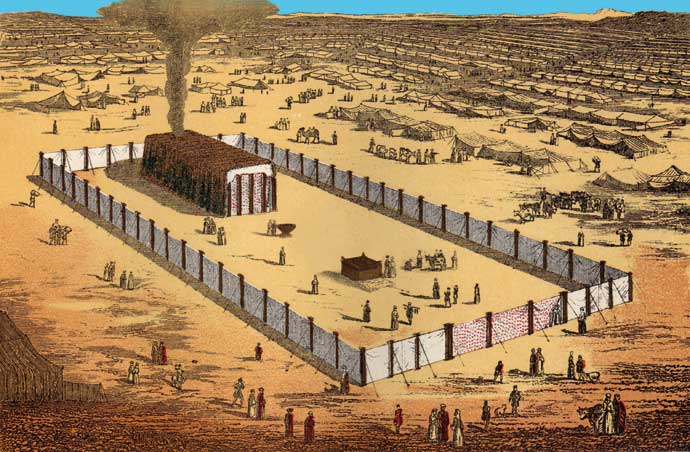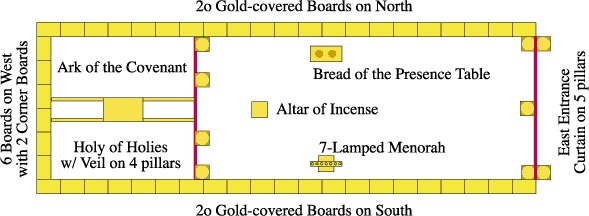Stepping Back Into The Past Through Technical Layout For The Tabernacle Of Moses
The very first place of worship set by God Jehovah is in the Garden of Eden. It served as a sanctuary because of God's presence but because of the first man and woman's rebellion, God then establish another place of worship known as the "Tabernacle" or the tent of worship. Have you heard it before?
Jan 31, 202250.2K Shares1.5M Views

The very first place of worship set by God Jehovah is in the Garden of Eden. It served as a sanctuary because of God's presence but because of the first man and woman's rebellion, God then establish another place of worship known as the "Tabernacle" or the tent of worship. Have you heard it before?
Most people are not familiar with this. Here is my good news! Through this article, I will show you the technical design of Moses' Tabernacle, and I will help you become familiar with this building.
What's The Inside Of The Tabernacle
The tabernacle, or "tent of meeting," that God commanded Moses to build in the wilderness is one of the sites referenced in the Bible as places of worship. It served as a sanctuary for 485 years, from 1512 B.C. through the building of Solomon's temple in 1027 B.C.
God gave Moses clear instructions for the construction and decoration of the tabernacle.
They fashioned a beautiful curtain to divide the tabernacle into two sections: Holy and Most Holy.
The ark of the covenant, crafted of acacia wood and gold, was kept in the Most Holy. A golden lampstand, a table, and an altar for lighting incense were all found in the Holy. A copper basin and a large altar sat in the courtyard. The Israelites were reminded of their pledge to obey Jehovah by the ark of the covenant.
Who Are Allowed To Enter Into The Tabernacle
Aaron and his sons were chosen by Jehovah to serve as priests in the tabernacle. They had to look after it and make offerings to Jehovah there. Only Aaron, the high priest, had access to the Most Holy. Once a year, he did this to provide a sacrifice for his own sins, the sins of his household, and the sins of the entire nation of Israel.
Technical Layout For The Tabernacle Of Moses
Here is the Tabernacle technical model, which is based on the "text of the Law" as recorded in the book of Exodus. It's the foundation for the three "Messianic Images," which are certainly more artistic than technical in nature. For example, with my first image (which displays Christ's rib cage), the boards on the South aren't shown since they would obscure the view of the inside that they wanted to show. The goal of this technological architecture is to "bridge the gap" between symbolic art, Biblical study, and good reasoning.
Because Moses never specified the depth of the boards, the length of the tenons, or the precise placement of the corner boards and pillars, every model must make assumptions. Without a great archeological find, it is hard to tell exactly how the Tabernacle was laid out. To "prove" one's theoretical layout, one of the boards would have to be found and measured.
As I stated in my "Messianic Images," I believe the boards were miniature replicas of Noah's Ark which was 300x50x30 cubits) Because the length of the two tenons under each board or the depth of the board aren't specified in Scripture, I used the mathematical relationship between the two related dimensions that we do know—the width of the Ark and the boards. We can easily establish the mathematical scale between the two things, which is 1 to 33.333 (infinitely repeating 3's), because Noah's Ark was 50 cubits wide and the boards were 1.5 cubits broad. This ratio may now be applied to the two unknown measurements, yielding a visible board length of 9 cubits and a board depth of 0.9 cubits for the visible board (the upper portion not covered by the silver bases). When the Tabernacle's support bars are taken into account, 0.9 cubits does not appear to be an odd number. The breadth of the boards would be efficiently rounded to an even 1 cubit if these support bars were 0.1 cubits in diameter (1.8 inches).
For those who think that the measurements are overly imaginative, it's worth noting that various Jewish Rabbis and authorities affirm that the boards were roughly one cubit thick. For example, to read a Jewish Encyclopedia.com description of the Tabernacle. Similarly, the renowned New Advent Catholic Encyclopedia supports the 1-cubit board thickness and states that the silver bases were "approximately 1 cubit high."
Now, if this theory is correct, these determined dimensions should allow for the construction of a good operational layout. When the boards are 0.9 cubits thick, the measurements look like this. The Tabernacle's support bars (5 on each side) were 0.1 cubits (1.8 inches) in diameter, making the 0.9 cubit thickness of the walls an even 1 cubit. The third hypothesis is that the pillars' width matched the depth of the walls, making them each 0.9 cubits wide.
Some Silver-Base-Burying Hypothesis
- It would provide a far more solid platform. Consider how difficult it would be to set up these 15-foot-tall gold-plated boards in desert winds. These bases would be exceedingly tippy during the setup process if they weren't dug into the ground, risking crushing a poor Levite worker.
- From floor to rafters, the Temple walls were gold. Why should there be silver inside the Tabernacle if there was none inside the Temple?
- Symbolically, the Tabernacle grew into the Temple as if it were a living thing. A tree! For some reason, palm trees were carved into the walls of the Temple all over. When you plant silver bases in the ground, they're like seeds. The boards' tenons are the roots. This is how it works: The Tabernacle grows out of the ground, and over time, it grows bigger and bigger until it looks like the Temple.
- Sinking foundations is a frequent and architecturally good construction strategy. When God asks Job, "What are the foundations of your house?" he refers to sunken foundations "Were you present when I laid the earth's foundations? What foundations were laid, and who lay the cornerstone?"(Job 38:4-7).
Tabernacle's Feature
- Ark
- Curtain
- Pillar of the curtain
- Holy
- Most Holy
- Screen
- Pillar for the screen
- Copper socket pedestal
- Incense altar
- Table of showbread
- Lampstand
- Tent Cloth of linen
- Tent Cloth of goat hair
- Covering of ram skins
- Panel frame
- Silver socket pedestal under panel frame
- Bar
- Silver socket pedestal
- Copper basin
- Altar of burnt offering
- Courtyard
- Entrance
- Linen hanging curtains
For reference you may examine the account of Exodus Chapter 25-30.
Conclusion
The article aided us in comprehending and imagining what it is like to serve inside the Tabernacle. The technical details of the Tabernacle are found in Exodus, where the "letter of the law," as it were, was written down. The article demonstrates that God of Moses established a clear standard for worshiping him, not just by ourselves, but with other faithful servants.
Latest Articles
Popular Articles

